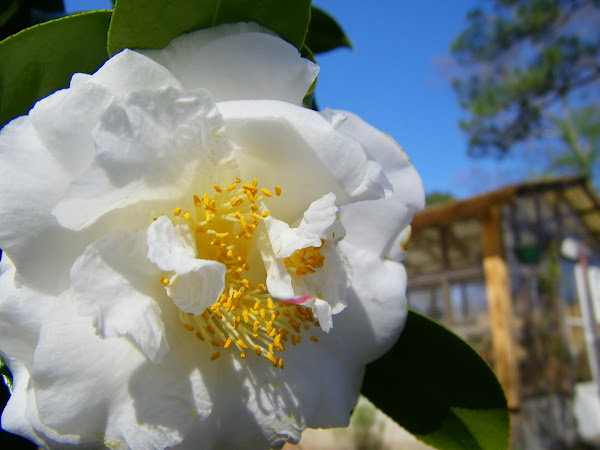Now is the time of year to start looking for blooms to start showing on your night blooming cereus.
|
Night Blooming Cereus
A midsummers night bloom could be a better common name for the night blooming cereus. Few people would ever buy this plant upon first inspection, because gangly and downright homely, come to mind, but let this plant bloom and everyone just has to have one. It is hard to imagine that such a common looking plant could have such a stunning blossom. Odder yet, it only opens in the late evening, but it is worth losing a little sleep over.
Two plants are given the common name night blooming cereus. They include Selenicereus and the Hylocereus genus. These plants are very similar in their growth habit and in their flowering. They are both members of the cactus family and are vigorous vining plants. The fast growth, coupled with the gangly stems, make them somewhat awkward in the interior landscape, but when they bloom -- it will take your breath away.
Hylocereus undatus is probably the most common plant we see. This plant originated in the tropics. It has slender, 3-ribbed light green to yellow green stems, that either climb or hang. They have short, sparse spines. The flowers open as funnel shaped blooms up to a foot or more in width. They only open at night, and the flowers form all along the stems.
Selenicereus is native to the Caribbean Islands and has slender cylindrical stems, green when young, and turning slightly purple as they mature. It also forms a quick growing slender stemmed plant. Another common name for this plant is "Queen of the Night".
Both of these plants are worthy of growing for the blooms alone, but don't hop in the car to go buy one -- they aren't commonly found gracing (or detracting) from the shelves in nurseries. These plants would truly be classified as ‘pass-along' plants -- those we get cuttings or starts from. If you can find someone who has one, they would be more than happy to share, because the plants are prolific growers, and easy to grow.
This plant is grown as a houseplant, but prefers a trip outdoors for the summer months. Place the container under a shade tree where it gets filtered light, but not direct sunlight in the afternoon. With a flower so showy, you may think it is difficult to grow, but the opposite is true. It basically takes care of itself. The only thing that would be a problem would be waterlogged soils. It prefers a well-drained soil with organic matter added -- a half-and-half mixture of sand and commercial potting soil should do. The sandy mix is preferred, since this is a cactus. Feed it monthly during spring and summer with any water soluble.
The plant usually begins to set flower buds in July through September in Arkansas. You will notice a bud appearing along the edge of a leaf. You need to watch it daily to gauge when it will bloom. The buds increase dramatically in size. The day of blooming, the bud will begin to open about 9 or 10 pm, and be wide open by midnight. When they're ready to open, they do so in dramatic fashion, literally before your eyes -- you can see the movement. We once did time lapse photography for a show, and it was amazing to all of us present. The size and shape of the blooms is outstanding enough on its own, but the fragrance can scent an entire room.
You don't want to miss the flowering display, because each bloom only lasts for that one night. By sunrise the flower is spent. I have cut a bloom and put it in a vase of water in the refrigerator where it did last for an extra day, minus the fragrance, but it made viewing somewhat constrictive -- you had to have your head in the icebox to see it!
To encourage annual blooming, don't keep it as actively growing during the fall and winter months. Reduce watering, and avoid fertilization. The soil should be allowed to dry between watering. This is the season where you want the plant in a spare bedroom -- getting needed sunlight, but out of sight! Rootbound plants tend to bloom better, so don't repot your plant very often. As the plant begins to grow in the spring, increase watering but only slightly. This is a cactus, and it doesn't need as much water as other houseplants. Too much water can cause rootrot and eventual death.
If you can find someone with a plant, ask for a cutting. They root extremely easily. Take a section of stem roughly two to four inches in length, put it a sandy potting soil, and moisten it. It should be rooted with three to six weeks. It will usually take two to three years before you have a plant that begins blooming, but then stand back and enjoy. Some people find that their plants bloom every year, once blooming begins, while others have an alternate blooming cycle.
If you can't find a plant locally, there are some mail order sources.
If you have a night blooming cereus, consider hosting a late night party for when it is in bloom -- you can amaze and astound your friends. Just don't tell them how easy it is to grow.



No comments:
Post a Comment